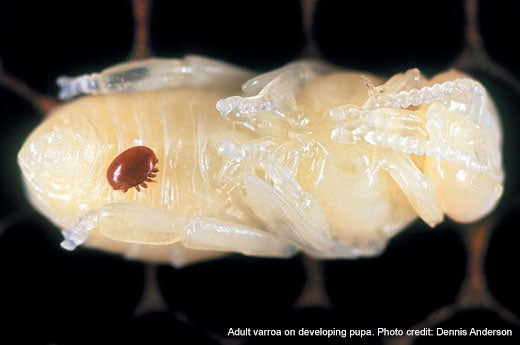VARROA MITE
Officials in New South Wales have enacted a bee lockdown after detection of the Varroa destructor mite at the Port of Newcastle. This threatens Australia’s status as the only major honey producer to have avoided this deadly pest. Along with the use of pesticides, Varroa destructor has been the primary cause of colony collapse in the U.S. and is recognised as the most damaging pest of the western honey bee, Apis mellifera.
In June 2022, Varroa destructor was confirmed in hives in New South Wales (NSW). These mites have not yet been detected in any other Australian state. Monitoring by all beekeepers nationwide is key and will support early detection.
WHAT ARE VARROA MITES?
Varroa mites (Varroa jacobsoni and Varroa destructor) are external parasites that feed and reproduce on adult and immature honey bees. This causes malformation and weakening of the honey bees while also transmitting diseases such as deformed wing virus (DWV). Varroa can quickly spread when infected bees have contact with uninfected bees, hive tools, plants, and other contaminated equipment. This can also occur naturally when bees are out foraging, during a swarm or when they rob weaker colonies. The condition of a honey bee colony being infested with Varroa mites is called varroosis.
Although the Varroa complex includes multiple species, the main two variations are Varroa jacobsoni and Varroa destructor. Until 2000, it was believed that Varroa jacobsoni was the mite responsible for most honey bee colony losses. However, research published in 2000 indicated that a previously-unidentified species of the mite (Varroa destructor) was responsible for the damage, while Varroa jacobsoni was shown to be only moderately harmful to western honey bees.
A female Varroa destructor feeds on the hemolymph of a worker bee. The mite is the oval, orange spot on the bee's abdomen. Photograph by James Castner, University of Florida.
Adult female mite - Varroa destructor
Varroa destructor is a natural parasite of the eastern honey bee, (Apis cerana). On the eastern honey bee, V. destructor affects only drone brood and colonies are not significantly impacted. But on the western honey bee, (Apis mellifera), the V. destructor parasitizes both drone brood and worker brood which has a much bigger effect on the colony since western honey bees have very natural little resistance to V. destructor.
One way to test for Varroa destructor is with a sugar shake test. Get yours HERE!
NATIVE BEES AND VARROA MITES
The spread of V. destructor is a lesson on what can happen when organisms are moved outside their native ranges. Movement of the western honey bee to eastern Asia by man gave varroa the chance to move onto a new host. The presence of varroa on the western honey bee became increasingly alarming during the 1960s in Europe.
Apis mellifera, the western honey bee, is not the mite's natural host. In fact, the mite is native to Asia where it parasitizes another cavity-dwelling honey bee, Apis cerana (the eastern honey bee). The eastern honey bee is believed to have some natural defenses against the mite and consequently rarely is affected negatively by the mite.
Only when colonies of western honey bees were brought to Asia did people begin to realize how devastating the mites could be. Varroa’s host shift did not occur instantly, but over a period of 50-100 years. Since that time, the mite has spread around the world.
WHAT IS THE BREEDING CYCLE OF A VARROA MITE?
Here’s an overview of the Varroa life cycle.
- A pregnant female mite enters a single brood cell (prefers drone cells) containing a larva just prior to capping.
- Once the cell is capped, the female mite will move to the abdomen of the prepupa and chew a wound in its outer layer and lay two to five eggs.
- The first egg is a male and all the eggs after that are female.
- Once the Varroa mites hatch, they go through two larval stages (protonymph and deutonymph) before developing into an adult.
- It takes about 7–8 days for female Varroa mites to develop, and 5–6 days for males.
- Mating also occurs within the brood cell. Shortly after, the male mite dies inside the cell.
- Young female Varroa mites and the mother Varroa mites emerge from the brood cell with the emerging honey bee.
- The daughter Varroa mites will lay eggs in other brood cells after 2 weeks. Adult female Varroa mites usually live for 2 months but can overwinter on adult honey bees.

Image sourced from www.ars.usda.gov
Mite issues are most severe in late season when brood area is naturally declining. When a parasitized larva or pupae becomes an adult bee, they can carry 1-3 mature female mites. These mites will disperse to other adult bees before seeking out a larva in the brood to reproduce on. Once that spreads through the colony it will eventually collapse.
VARROA MITE DETECTION
Varroa destructor is a relatively large mite and can be seen with the unaided eye, yet by the time they reach this size, the mite is already a problem in the colony. The mites often are found feeding between segments on the bees' abdomens or crawling quickly elsewhere on the bees' bodies. Adult female mites are reddish-brown to dark brown and oval. Adult males are yellowish with light tan legs and a spherical body shape.
A much better way to look for Varroa in a colony is to examine bee brood. It is easier to find mites on drone brood because Varroa are attracted to drone brood more strongly than they are to worker brood, and because drone brood is easier to remove from the cells.
Under the Australian Honey Bee Industry Biosecurity Code of Practice, all beekeepers are required to check at least one hive per apiary for external parasites, twice per year, in autumn and in spring. The mites are very difficult to detect during regular brood inspections.
Therefore, beekeepers are required use one of the three detection methods. Click the links below to learn more about our products for testing, along with detailed instructions on how to perform the test.
| Sugar shake |  |
|---|---|
| Drone uncapping |  |
| Alcohol washing |  |
Alcohol washing is fatal to tested bees which is why we prefer sugar shaking, along with drone uncapping. Click HERE to get our sugar shake kit so you can test your bees as soon as possible!
HOW TO TREAT VARROA MITES
For most colonies worldwide, a varroa infestation means certain death unless a beekeeper intervenes with treatment. The hope is that with treatment the bees will develop some natural resistance over time. Meanwhile, beekeepers need to check hives for any signs of varroa, then treat accordingly.
The treatment of Varroa is an ever-changing science and a complex topic. Each type of treatment has a different application method depending on certain conditions. For this article, we will simply list a variety of treatments and discuss them in more detail in future articles. A few of the Varroa treatments include:
- Oxalic Acid
- Apiguard
- Apivar
- Formic Pro
- Thymol
WHY IS IT SO IMPORTANT TO REMOVE VARROA FROM AUSTRALIA?
As in other countries where Varroa has been found, it is expected that this mite could potentially kill between 95 to 100 percent of Australia’s feral European honey bee population, which will greatly reduce the pollination service they provide.
This scenario has been confirmed by recent research at the University of Sydney. The study found that when Australian honey bees were sent to America, none of the bees had any resistance to the mites. The conclusion is that a Varroa mite problem in Australia would have a devastating effect on bee populations and those industries that rely on pollination.
As the number of feral honey bees falls, the agriculture industry will be most affected. It is estimated that establishment of Varroa in Australia could result in agricultural losses of over $70 million (AUD) a year.
REPORTING IS KEY!
As beekeepers we must be diligent in being proactive and monitor for the presence of varroa in our hives and act accordantly. If you detect Varroa mite, call the Exotic Plant Pest Hotline to report your detection on 1800 084 881 (9am to 5pm, 7 days a week).
The detection and treatment of Varroa is an ever-changing science. Methods to deal with this pest have changed over time and might again in the future. SUBSCRIBE to our newsletter to stay up to date on this and all things beekeeping.
Additional Resources that might help you
- https://www.dpi.nsw.gov.au/biosecurity/seasonal-pests-and-diseases/spring/varroa-mite
- https://beeaware.org.au/pollination/preparing-for-varroa-mite/
- https://beeaware.org.au/archive-pest/varroa-mites
- https://www.planthealthaustralia.com.au/biosecurity/emergency-plant-pests/reporting-suspect-pests/
- https://agriculture.vic.gov.au/biosecurity/pest-insects-and-mites/priority-pest-insects-and-mites/varroa-mite-of-honey-bees
- https://www.agric.wa.gov.au/bees/varroa-mite-biosecurity-alert



